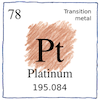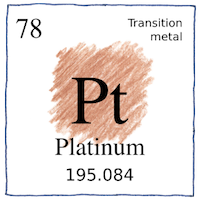London—Antonio de Ulloa,
Charles Wood,
William Brownrigg,
William Hyde Wollaston,
Smithson Tennant
elements

|
Platinum
It took many years for platinum to be fully recognized as a new element. Central Americans either discarded it or worked it cold into small items of jewellery. Julius Caesar Scaliger described it in 1557 as a metal from Central American mines impossible to melt. Spanish conquistadors in the Chocó region found small grains of it mixed in with gold in riverbeds. They called it platina, using the diminutive of silver, plata. Antonio de Ulloa spent ten years in the region on a scientific expedition for King Philip V of Spain and in 1748 published his Historical account of the journey to South America in which he described platina as a stone “not easily broken by a blow upon an anvil,” “not subdued by Calcination,” and said it was “very difficult to extract the metal it contains even with much labor and expense.” In 1741, Charles Wood obtained grains of platina in Jamaica, found that acid didn’t affect it and that you could not refine it. Wood gave samples to William Brownrigg, who tried to refine it using coppellation, the usual process for extracting silver from lead. Brownrigg recognized that platinum was a new element, but he concluded that repeating the usual refining process would only gradually dissipate the platina entirely, as described in a letter to the Royal Society in 1750. Carl von Sickingen in 1772 and Franz Karl Achard in 1784 produced malleable alloys of platinum and concluded it wasn’t malleable. Thus the matter seemed intractable, until William Hyde Wollaston and Smithson Tennant formed a secret partnership to refine metals from platina ore, resulting not only in malleable platinum in 1805, but also discovering palladium in 1802, osmium in 1803, iridium in 1803, and rhodium in 1804.
Atomic number 78
Platinum is harder and less reactive than gold, but useful as a catalyst. In a car’s catalytic converter, platinum converts carbon monoxide into carbon dioxide and water. In a small handwarmer, platinum converts methyl alcohol into formaldehyde and heats up in the process. In a fuel cell, platinum combines hydrogen and oxygen to produce water and electricity. Plus if you can afford it, platinum jewellery or other platinum accessory conveys prestige like nothing else.
Stuff that doesn’t tarnish
Platinum is more prestigious more rare more durable more expensive than gold but nothing to compare to you.



After all, in regard to the sentiment expressed in “Stuff that doesn’t tarnish,” these are made of, as it were, poetry, not only science. Ladies and gentlemen, you have my permission to put that poem into your next Valentine card (not for commercial purposes).
See also in The book of science:
Readings in wikipedia:
Other readings: